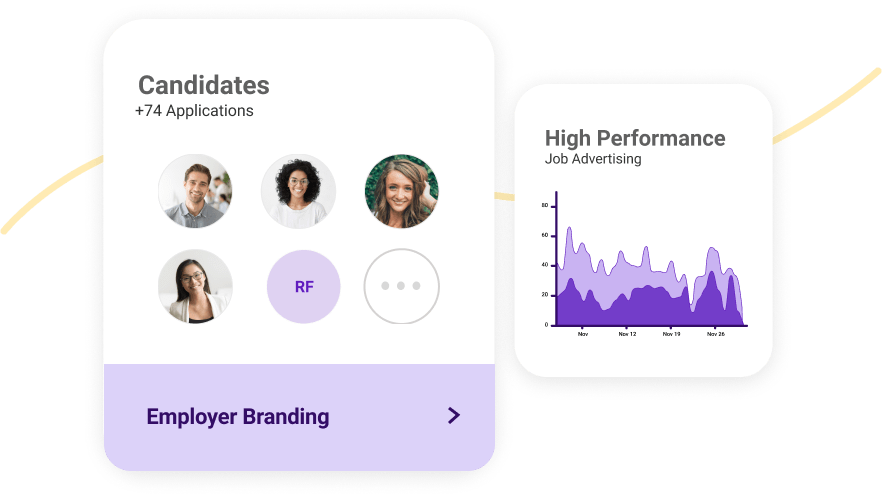High-Volume Recruiting Guide

Recruiting a workforce is challenging in any industry. Hiring managers must consider several factors at any given time, such as:
- Speed
- Cost
- Quality of candidate
These are just some of the considerations that go into making difficult hiring decisions. When the number of candidates you need to hire and the amount of time you have to do it seem to be an impossible challenge, like during the holidays or when opening a new location, things can get crazy. Welcome to the world of high-volume recruiting.
High-volume recruiting, or volume recruiting for short, is the process of hiring many employees in a short amount of time. This can mean different things to different industries.
For highly-specialized positions, 20 requisitions a week may be a lot. For others, like warehousing or transportation, high volume could mean up to hundreds of new hires weekly.
Luckily, technology has made it easier than ever to make large-scale hires at an incredible pace – without breaking the bank.
In this guide, Talroo will walk you through the main elements of high-volume hiring. We’ll talk about the recruiting process and best practices you should follow. We’ll focus on the most important recruiting metrics, and the challenges you’ll face on the way to your goal.
This guide will provide everything you need for a winning recruiting strategy.
High-Volume Recruiting Challenges

Getting quality hires fast – and a lot of them – is no easy feat. There are many challenges inherent to recruiting, especially in high-volume industries. Most recruiters struggle with the same pain points.
You don’t need unqualified candidates applying or inexperienced applicants throwing their hat in the ring. You don’t want to spend a ton of money to find just a few qualified candidates. You certainly don’t need the process to take longer than your allotted timeline. Double your needs and half your time – that’s the challenge of high-volume recruiting.
Before diving into the volume recruiting process, consider the toughest hiring challenges you normally face. Not enough applicants? Lack of qualified ones? Candidate sourcing issues?
Whatever your problems are, they’re fixable. With the right tools, a plan and budget you stick to, and a carefully crafted strategy, you can put your pain points behind you.
Learn how to solve your recruiting challenges →
The High-Volume Recruiting Process
The high-volume recruiting process is complicated and takes time. Let’s break it down.
First, there’s the initial groundwork and planning. Based on the plan you create, you can draft a budget. Where your target candidate audience is will decide where you source from. Finally, throughout the candidate journey, you can guide that audience with nurturing tactics. These are all important steps to getting the hires you’re looking for.
HVR planning

Hiring is often a long and grueling process. With high volume, you don’t have the time to sit around. The first step in the strategic high-volume recruitment process is to make a plan.
You’ll need to consider the number of hires you need as well as the specific roles you wish to fill. What are your hiring deadlines, and what schedule will you establish to get the candidates you need in time?
Creating a calendar, identifying the tools you’ll be using, and considering industry insights as well as your overall recruiting strategy, is a great place to start your HVR journey.
Discover how to improve high-volume recruitment planning →
HVR budgeting

Before you can go much further in the planning process, you’ll need to think money. Many recruiters list budget concerns as a top challenge they face. We’ll provide the tools you need to get your high-volume hiring budgeting on track.
First, consider the number of hires your organization needs and the time frame you need them in. Then, go through your list of recruiting costs. Some are fixed, while others need to be calculated and expensed. With these goals and expenses in mind, you can craft your volume recruiting budget.
This groundwork will allow you to calculate your cost per hire, and hopefully, stick to it.
Discover how to improve your recruitment budgeting →
HVR sourcing

One of the most important elements of a recruiting strategy is candidate sourcing. Every position is different and the applicants they attract are different, too. High-volume recruiters should tailor their sourcing strategy to the type of candidates they’re looking for.
Most recruiters source through a mix of:
- Job boards
- Employee referrals
- Hiring events
- Social media
Perhaps the most important tool, especially at scale, is a comprehensive talent community. This is where recruiters typically begin their process. In addition, your applicant tracking system (ATS) should allow you to engage and even re-engage potential candidates.
Today, there are more tools than ever before to find the candidates you need.
Learn how to optimize sourcing strategies for the right candidates →
HVR nurturing

Providing a positive candidate experience is an important, but often underrated, component of a successful volume recruiting strategy. That all starts with candidate nurturing. From the first touchpoint someone has with your brand, they need to feel educated and engaged.
A good understanding of the recruiting funnel is crucial here. There are different takes on the specifics of the popular recruiting methodology. It is most often segmented into top, middle, and bottom of the funnel. The top of the funnel is for awareness (do they like your brand and are they going to apply?), the middle is for consideration (what do you think of their application?), and the bottom is for decision (will you interview, and eventually hire them?).
There are different nurturing strategies for each stage of the applicant’s journey to get people moving down the funnel. Using them accordingly will elevate your candidate experience. That means higher application numbers and an enhanced recruiting strategy.
Learn how to build volume candidate nurturing strategies →
High-Volume Recruiting Metrics

If you want to keep up with 21st century recruiting, you need to understand three things: metrics, metrics, metrics.
Metrics are important for both the beginning and the end of a hiring cycle. On the front end, you should be aligning your goals with metrics to be mindful of. Toward the end of the journey, use those metrics to analyze what went well and what you can improve on in the next wave of hiring.
There are several high-volume recruiting metrics to keep in mind when going through the long process. If you’re focused on improving your number of qualified hires, the applicant to hire ratio is an important metric to understand. If timeliness is your biggest concern, your interview to hire ratio and time to hire (or time to fill) are the ones to watch.
No matter your concerns, it’s always important to maintain a metric-driven mindset. This is the only way to continuously improve your high-volume recruiting strategy.
Learn about important recruiting metrics to improve hiring →
Volume Recruiting by Industry
Every industry has its own hiring hurdles. For some sectors, seasonality can be a major factor. For example, the summer, tax season, and the winter holidays each present their own timely needs.
The more qualified you need your applicants to be, the more expensive they are to hire. This can present an issue for high-skill, high-demand industries like hospital and healthcare.
Location is a factor that might not matter in industries such as logistics and transportation. For others, it’s an important element that can drive or deter job seekers from applying.
Some businesses recruit for several industries at once. This presents unique challenges that only talent acquisition professionals understand.
Talroo provides the solutions you need for high-volume hiring across most industries, including:



